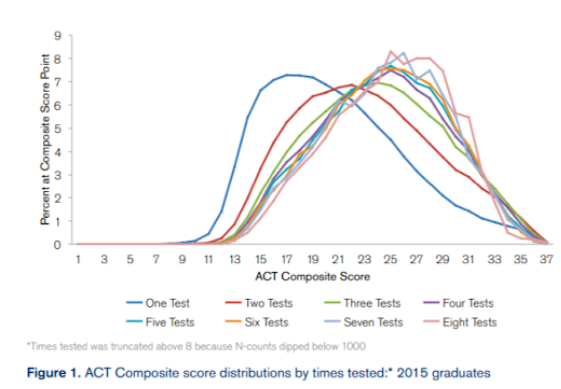
Do you want to know how your ACT score compares to those of your dream school or even the rest of the nation? This type of data will help you understand where you stand among your high school peers, especially with the percentiles that college admissions might use to judge your score.
What Is The Average Act Score?
The ACT is a multiple-choice, 3-hour long, standardized test that colleges and universities use as an entrance exam to qualify potential students. This test encompasses multiple academic skill areas including English, reading, mathematics, and scientific reasoning, as well as offering an optional writing portion. The writing portion ranges in score from 2-12.
Each individual section is graded on a scale of 1-36, which are then averaged to form the overall composite score out of 36. From data collected by the 2020 ACT Research Publication, the current national average ACT score is 20.6.
How ACT Scoring Works
Students’ ACT tests are scored on a scale of 1-36 by section, then the four test scores are averaged into a composite score. This composite score is rounded to the nearest whole number, with fractions less than one-half rounded down and fractions one-half and above rounded up.
In scoring the tests, there is no guessing penalty: incorrect answers do not lose points. Instead, students are encouraged to fill in every question for a better chance at guessing correct answers, as they will not receive any penalty for guessing.
If you take the ACT more than once, you may “superscore” your scores to obtain your highest possible score. Superscoring means that you take your best section scores across all of your attempts at the test and average those 4 top section scores for an overall best composite score. Most U.S. universities recognize superscores.
ACT Average Percentiles
While the graders of the ACT calculate each individual’s composite raw score, these are typically not the focus when institutions are analyzing students’ scores. Instead, they’re more likely to care about average percentiles.
These place your score among your peers’ scores in a comparative ranking. Therefore, along with your composite score, you will receive a percentage ranking such as 70th percentile or 99th percentile. This means that you scored higher than that percent of students who took the same test as you on test day.
Percentiles are super important to understand when looking at your test results, as they will tell colleges and universities how competitive you are against your peers in a standardized test context.
For example, if you were to receive a composite score of 24, your composite percentile would be the 74th percentile. So therefore you scored above 74% of your peers who took the test with you.
Percentiles can also be broken down into each of the sections of the ACT. For our example with a score of 24, the English percentile is 75th, math percentile is 74th, reading percentile is 71st, and the science percentile is 77th.
This information give institutions insight into a student’s abilities in multiple academic skillsets, so percentiles have a huge impact on students and should be understood before taking the test. Percentiles are a good benchmark for comparison when wondering, “what’s a good score on the ACT?“
The table below gives detailed information on the percentiles associated with each score that students can receive on the ACT.
| Score | English Percentile | Math Percentile | Reading Percentile | Science Percentile | Composite Percentile |
| 36 | 100 | 100 | 100 | 100 | 100 |
| 35 | 99 | 99 | 98 | 99 | 99 |
| 34 | 96 | 99 | 96 | 98 | 99 |
| 33 | 94 | 98 | 94 | 97 | 98 |
| 32 | 92 | 97 | 91 | 96 | 96 |
| 31 | 91 | 96 | 89 | 95 | 95 |
| 30 | 89 | 94 | 86 | 93 | 93 |
| 29 | 88 | 93 | 84 | 92 | 90 |
| 28 | 86 | 91 | 82 | 90 | 88 |
| 27 | 84 | 88 | 80 | 88 | 85 |
| 26 | 82 | 84 | 77 | 85 | 82 |
| 25 | 79 | 79 | 74 | 82 | 78 |
| 24 | 75 | 74 | 71 | 77 | 74 |
| 23 | 71 | 70 | 66 | 71 | 70 |
| 22 | 65 | 65 | 61 | 64 | 64 |
| 21 | 60 | 61 | 55 | 58 | 59 |
| 20 | 55 | 58 | 50 | 51 | 53 |
| 19 | 49 | 54 | 44 | 45 | 47 |
| 18 | 45 | 49 | 39 | 39 | 41 |
| 17 | 41 | 42 | 34 | 32 | 35 |
| 16 | 37 | 33 | 29 | 26 | 28 |
| 15 | 32 | 21 | 24 | 19 | 22 |
| 14 | 25 | 11 | 19 | 14 | 16 |
| 13 | 19 | 4 | 14 | 10 | 10 |
| 12 | 15 | 1 | 10 | 7 | 5 |
| 11 | 11 | 1 | 5 | 4 | 2 |
| 10 | 7 | 1 | 3 | 3 | 1 |
| 9 | 3 | 1 | 1 | 1 | 1 |
| 8 | 2 | 1 | 1 | 1 | 1 |
| 7 | 1 | 1 | 1 | 1 | 1 |
| 6 | 1 | 1 | 1 | 1 | 1 |
| 5 | 1 | 1 | 1 | 1 | 1 |
| 4 | 1 | 1 | 1 | 1 | 1 |
| 3 | 1 | 1 | 1 | 1 | 1 |
| 2 | 1 | 1 | 1 | 1 | 1 |
| 1 | 1 | 1 | 1 | 1 | 1 |
What is the Average Score on the ACT
As shown above, the national average ACT score as of 2020 is 20.8. This score is made up of the individual section scores, whose scores vary around this composite average. The difficulty of each section of the ACT will be different for each student, depending on their strengths and weaknesses.
However, some sections are counted as easier because of the effort it takes to prepare for it. This is the case for the English portion of the ACT, as students know exactly what types of questions they will be asked, and it all centers around grammar rules and structures that do not change. It has also been said that there is ample time in this section for the number of questions given.
Other sections, however, may feel more like a time crunch because of the types of questions; this is typically the case in the reading portion because of the reading time and the complexity of the questions.
Average ACT Scores by Section
| English | 19.9 |
| Math | 20.2 |
| Reading | 21.2 |
| Science | 20.6 |
English ACT Section
The English portion of the ACT lasts 45 minutes and consists of 75 questions. It covers all aspects of grammar including punctuation, usage, and sentence structure, as well as rhetorical skills.
Math ACT Section
This section is 60 questions and students are allowed 60 minutes to complete it. This gives students around one minute per question, although some problems would ideally take you less time.
The ACT math section covers topics including pre-algebra, elementary algebra, intermediate algebra, coordinate geometry, plane geometry, and trigonometry. Most students have studied these topics in depth by the end of eleventh grade.
Reading ACT Section
There is a portion of the ACT that examines students’ reading comprehension.
The ACT Reading section lasts 35 minutes and consists of 40 questions, meaning students have just under nine minutes for reading each passage and answering the questions on it. Students must read four passages- one of them being a paired passage (two selections that must be compared)- and answer questions regarding main ideas, important details, sequence of events, and comparisons.
Science ACT Section
The ACT Science section measures students’ skills in interpretation, analysis, evaluation, reasoning, and problem-solving. The topics tested include biology, chemistry, Earth/space sciences, and physics. Students must answer 40 questions in 35 minutes.
Change In ACT Scores Over Time
The average ACT composite score is not the same year-to-year. This is due to many influencing factors, including participation rate and whether or not students receive tutoring for the test. T
he ACT began in 1959, and from 1992 to 2006, the average score gradually increased from 20.7 to 21.2. Scores then began to fluctuate, but overall decline, from 2007- 2020. The current average score is 20.6, which is extremely similar to the average rate in 1992.
Average ACT Composite Scores By State
Something important to understand when looking at average state scores is that for larger states, it is harder to get a high average because more people fall at the tail end of the scores.
It is also very important to look at the participation rate per state. For example, the state with the highest average ACT score is Massachusetts at 26. However, only 18% of seniors in 2020 took the test. On the other hand, Utah has 100% participation, with an average score of 20.2. While this is a lower score, it is more impressive when the participation rate is taken into account. Participation rate varies among states because some states require ACT testing, while other states allow students to decide whether or not to take the test.
Top 10 Highest Scoring States
- Massachusetts – 26
- Connecticut – 25.9
- New Hampshire – 25.7
- New York – 24.9
- Maine – 24.9
- Rhode Island – 24.8
- Illinois – 24.7
- Michigan – 24.6
- New Jersey – 24.4
- Virginia – 24.4
Bottom 10 Lowest Scoring States
- Nevada – 17.9
- Mississippi – 18.2
- South Carolina – 18.4
- Hawaii – 18.5
- Lousiana – 18.7
- Oklahoma – 18.7
- Alabama – 18.8
- North Carolina – 18.8
- Arkansas – 19
- Arizona – 19.1
Average ACT Score and Participation Rate by State
As mentioned above, these average scores vary due to many reasons. The primary reason is the participation rate, which could be due to required testing or favoring the SAT test instead. Below is the breakdown of average ACT composite scores and participation rate by state, as well as whether or not the state requires students to take the ACT.
| State | Required? | Participation Rate | Mean Composite Score |
| Alabama | Yes | 100% | 18.8 |
| Alaska | No | 33% | 20.1 |
| Arizona | No | 71% | 19.1 |
| Arkansas | No | 100% | 19 |
| California | No | 19% | 23.3 |
| Colorado | No | 25% | 23.7 |
| Connecticut | No | 19% | 25.9 |
| Delaware | No | 11% | 24.2 |
| District of Columbia | No | 33% | 23.1 |
| Florida | No | 46% | 20.6 |
| Georgia | No | 43% | 21.7 |
| Hawaii | Yes | 82% | 18.5 |
| Idaho | No | 28% | 22.7 |
| Illinois | No | 31% | 24.7 |
| Indiana | No | 25% | 22.6 |
| Iowa | No | 68% | 21.1 |
| Kansas | No | 82% | 20.4 |
| Kentucky | Yes | 100% | 19.5 |
| Louisiana | Yes | 100% | 18.7 |
| Maine | No | 5% | 24.9 |
| Maryland | No | 19% | 23.8 |
| Massachusetts | No | 18% | 26 |
| Michigan | No | 17% | 24.6 |
| Minnesota | No | 92% | 21.3 |
| Mississippi | No | 100% | 18.2 |
| Missouri | No | 78% | 20.7 |
| Montana | Yes | 100% | 19.9 |
| Nebraska | Yes | 100% | 19.9 |
| Nevada | Yes | 100% | 17.9 |
| New Hampshire | No | 12% | 25.7 |
| New Jersey | No | 23% | 24.4 |
| New Mexico | No | 56% | 19.3 |
| New York | No | 20% | 24.9 |
| North Carolina | Yes | 100% | 18.8 |
| North Dakota | Yes | 94% | 19.6 |
| Ohio | Yes* | 100% | 19.9 |
| Oklahoma | Yes* | 100% | 18.7 |
| Oregon | No | 42% | 21 |
| Pennsylvania | No | 15% | 23.7 |
| Rhode Island | No | 11% | 24.8 |
| South Carolina | Yes* | 76% | 18.4 |
| South Dakota | No | 70% | 21.7 |
| Tennessee | Yes* | 100% | 19.3 |
| Texas | No | 38% | 20.2 |
| Utah | Yes | 100% | 20.2 |
| Vermont | No | 23% | 23.3 |
| Virginia | No | 19% | 24.4 |
| Washington | No | 20% | 22.9 |
| West Virginia | No | 38% | 20.9 |
| Wisconsin | Yes | 100% | 20.1 |
| Wyoming | Yes | 100% | 19.7 |
*Ohio, Oklahoma, South Carolina, and Tennessee all require that students take either the SAT or the ACT; typically the individual districts determine which one students will take.
How do Colleges Consider ACT Scores?
The ACT is used as a measure of evaluating students and how well they can match with the rigor of certain schools. Most colleges and universities have a typical ACT score range that they will consider for competitive prospective students. During the peak of the pandemic, most universities stopped requiring standardized tests as a part of their application process, and many schools have decided to retain this policy for the future.
However, it is still good to know what colleges typically expect for competitive students. For example. Harvard and Columbia have an average ACT composite score range of 33-35, the University of Pennsylvania has an average composite score range of 31-34, while Leigh University has an average composite score range of 29-33. This obviously varies among schools, but there is no doubt that aiming for a composite score within the range of your dream school is the best goal to set.
One last thing to note is that the ACT is also taken into the context of the rest of the student’s application—including their extracurricular activities and GPA. While it is always good to reach or exceed the average standardized test score of the colleges you are applying to, it is not the end of the world if you don’t reach it.
What College or University has the highest average ACT score?
In fact, the California Institute of Technology and the Massachusetts Institute of Technology together hold the top spot of the highest average ACT composite score with an average of 35.
Top 10 Colleges with the Highest Average ACT Score
| College/University | Acceptance Rate | Mean Composite ACT Score |
| California Institute of Technology | 6.4% | 35 |
| Massachusetts Institute of Technology | 6.7% | 35 |
| Harvey Mudd College | 13.7% | 34 |
| Yale University | 6.1% | 34 |
| University of Chicago | 6.2% | 34 |
| Northwestern University | 9.1% | 34 |
| Johns Hopkins University | 11.2% | 34 |
| Harvard University | 4.6% | 34 |
| Washington University in St. Louis | 13.9% | 34 |
| Princeton University | 5.8% | 34 |
The above table contains very interesting information to look at, but do not let it scare you away from applying to top schools if your score is not yet where you want it! Tutoring for the ACT is very real and extremely helpful to help clarify points about the test and practice those algebra and critical thinking skills you haven’t used in a while. Truthfully, there are no good or bad scores when it comes to the ACT. If you are aiming to gain admission into an Ivy League school, a 34 would be a good target score for the ACT. If you are aiming to attend a state school, scoring at or above your state’s national average would be an ideal start. And it is good to know that there are many facets to college applications, so making sure that you shine in your essays is key- right next to proper ACT prep.
Why are Average Percentiles Important?
ACT Average Percentiles give institutions rankings of scores to compare students against to help determine competitive applicants. This means that individual scores do not matter as much as percentile rankings do, in the eyes of most colleges and universities. The ACT percentile indicates the number of students who scored higher or lower than you, placing you in a rank among your peers.
What is a good ACT score for 2021?
So now you understand what the average ACT score was in 2020 and the importance of ACT scores and percentiles according to colleges. The next question to ask is what score should you be aiming for? This depends on what institutions you plan to apply to, and how competitive you want to appear to them. It is always good practice to research the average ACT composite scores for individual institutions and then set your personal goal based on that research. Most institutions will publish the 25th percentile, 50th percentile, and 75th percentile scores of their recently admitted class.
A competitive composite ACT score for 2021 is 24-25, which would place students in the 75th percentile. This is labeled as “good”. To be in the 90th percentile, which is considered “excellent”, students need to reach a composite score of 29. Again, data such as this should help you frame your own ACT composite goal so you can build a competitive application for your dream school!
Tips for ACT Success
The average ACT score shouldn’t necessarily be your goal, but a benchmark to compare yourself to.
Set a practical, yet ambitious goal for yourself.
Understanding your own abilities is key when setting your goal for standardized tests such as the ACT. Some students may aim for the national average, while others may reach beyond that bar. It all depends on your skillset and your willingness to prepare yourself for the test.
Take the ACT multiple times.
It is pretty rare that you will hit your goal the first time you take the test. This does not mean you failed in any respect- it means you can learn from your mistakes and prepare better for the next time you take the test. Don’t be afraid to walk in that testing room multiple times until you can walk out with a score you are satisfied with.
Average ACT Improvement
According to research conducted by ACT.org, the number of students who retest after their first ACT has been increasing. Almost half of students are now retesting, and 57% of these students increase their scores! On average, students who repeatedly test have a composite score of 2.9 points higher than students who only test the test once. This points to the idea that taking the test multiple times is advantageous if you are not happy with your first composite score.
The figure below contains information obtained by Matt Harmston, MA, and Jill Crouse, Ph.D., with ACT Research and Policy on how students’ scores changed with taking the test multiple times. It can clearly be seen that from just one test (blue) to two tests (red), students’ peak scores increased from 13-19 to 19-24. Even more so when students took the test eight times, reaching peak scores of 25-31! You don’t necessarily need to take the exam eight times, as that could be a source of stress from constantly studying to being a financial burden, but the idea of taking the exam two times was gaining popularity among students before the pandemic. The increase shown here can greatly affect a students’ chances of getting into their dream school!

Recognize your weaknesses.
Maybe it takes you a very long time to read a reading passage, and that costs you precious minutes on practice tests. Maybe you struggle with graphs and tables in the math sections of the test. Recognizing these weaknesses is important during test prep so that you can target these areas of the test and find ways to push past those barriers to success. Sometimes it takes an outside view to notice these problem areas, and that’s where tutoring becomes a huge help in studying for the ACT.
How to Bump Your ACT Score Above the Average
Here at SoFlo ACT tutoring, seasoned test-takers from top colleges are just waiting to help you plan for and reach your goal ACT score. Our tutors provide students with a tailored curriculum with official ACT practice tests. Try out our tutoring service now to see a score in your desired percentile! Schedule a free consultation today.
About the Author

Keli Pegula is a sophomore at Dartmouth on the Pre–Med track. She’s a SoFlo tutor who scored 1480 on her SATs and 34 on her ACTs. When she’s not at school in Hanover, she might be in her hometown of Scranton, Pennsylvania — the town where the iconic TV show The Office is set!









